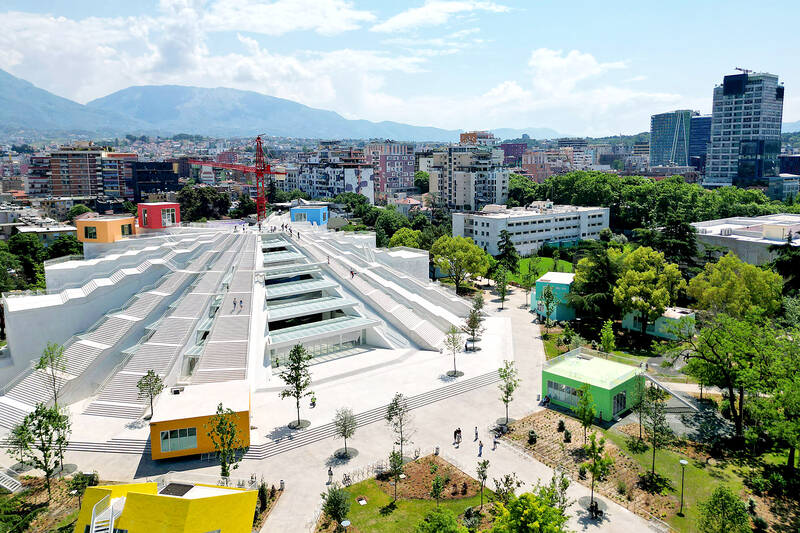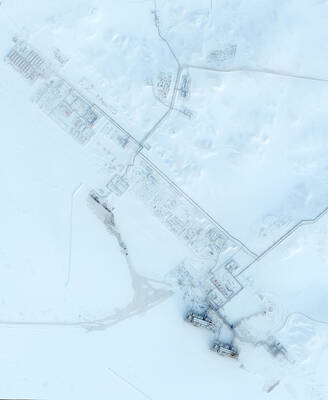It was built as a bizarre memorial to Albania’s paranoid communist dictator who cut the nation off from the rest of the world. Now a brutalist pyramid in the heart of Tirana hopes to become a beacon of the Balkan nation’s transformation.
The behemoth fit for a pharaoh was designed by Enver Hoxha’s daughter as a museum to his memory just a few years after his death in 1985.
Inside the gray pyramid sat a huge gleaming statue of the “Great Teacher,” who ruled the hermetically sealed nation for four decades. Now it is being turned into a hub to boost Albania’s embryonic technolgy sector.

Photo: AFP
“What used to serve to glorify an individual has been completely overturned, it’s becoming a place designed to educate people, not dedicated to one person, but to thousands,” said Martin Mata, copresident of the Albanian-American Development Foundation (AADF), one of the project’s major stakeholders.
The 15 million euros project cofinanced by the AADF and Albanian authorities is to house an education center to train youngsters in all things digital in an after-school program that aims to attract 4,000 students a week.
Later this year, Tirana’s teenagers would be able to take classes in 3D modeling, computer programing and digital design on state-of-the-art equipment in the old communist relic.
The building has had several lives since the fall of communism and become a marker of the fast-changing nation, serving as a nightclub, NATO offices and a television studio, but its newest iteration might prove to be its most important, its backers hope, with Albania losing thousands of young people every year who leave to find work abroad.
“It’s money well spent,” Mata said. “If 10 years from now we see that 200,000 kids have participated — and if 30 percent of those kids chose a career path because of what they learned ... then mission accomplished.”
The pyramid’s once-dilapidated interior has been reimagined by Dutch and Albanian architects, with massive windows channeling natural light over colorful office blocks.
“Our ambition was to open it up to the public, to make it the people’s pyramid both inside and out,” architect Gent Agolli said.
The digital education program known as Tumo — which has been piloted in cities such as Paris, Yerevan, Beirut and Berlin — already welcomes about 1,000 young people a week to a complex at the national stadium in Tirana.
“All the knowledge acquired here will be useful to them now, but above all in the future, whatever profession they pursue,” Tumo Tirana director Shqipe Berisha said.
In September, the teenagers, mentors and professional trainers are to transfer their operations to the pyramid. The 12,000m2 structure would also house an array of businesses, bars and cafes.
The rents are to be used to subsidize Tumo Tirana, making the courses as accessible as possible to Albanian students.
For Berisha, the pyramid has long served as a symbol of Albania’s turbulent transformation.
“To me the pyramid is like a mirror of what Albania has been like over the years,” Berisha said.
For “our parents [it was used to] try to explain the regime. In my time we used to slide down the pyramid’s [exterior], after that it was in bits and pieces just as the country was in bits and pieces. Now it is open. It reflects the openness of the country,” she said.
Tumo student Amina Xhembulla, 15, has taken an interest in graphic design since enrolling, with pupils encouraged to create a portfolio showing off their work for universities or potential employers.
“It’s helpful, not stressful,” Xhembulla said as she scrolled through projects she had worked on. “You can use technology we can’t use at school.”
Asked for her opinion on the pyramid’s dark past, the teenager shrugged.
“I don’t know much about history,” she said.

VENEZUELAN ACTION: Marco Rubio said that previous US interdiction efforts have not stemmed the flow of illicit drugs into the US and that ‘blowing them up’ would US President Donald Trump on Wednesday justified a lethal military strike that his administration said was carried out a day earlier against a Venezuelan gang as a necessary effort by the US to send a message to Latin American cartels. Asked why the military did not instead interdict the vessel and capture those on board, Trump said that the operation would cause drug smugglers to think twice about trying to move drugs into the US. “There was massive amounts of drugs coming into our country to kill a lot of people and everybody fully understands that,” Trump said while hosting Polish President

Japan yesterday heralded the coming-of-age of Japanese Prince Hisahito with an elaborate ceremony at the Imperial Palace, where a succession crisis is brewing. The nephew of Japanese Emperor Naruhito, Hisahito received a black silk-and-lacquer crown at the ceremony, which marks the beginning of his royal adult life. “Thank you very much for bestowing the crown today at the coming-of-age ceremony,” Hisahito said. “I will fulfill my duties, being aware of my responsibilities as an adult member of the imperial family.” Although the emperor has a daughter — Princess Aiko — the 23-year-old has been sidelined by the royal family’s male-only

A French couple kept Louise, a playful black panther, in an apartment in northern France, triggering panic when she was spotted roaming nearby rooftops. The pair were were handed suspended jail sentences on Thursday for illegally keeping a wild animal, despite protesting that they saw Louise as their baby. The ruling follows a September 2019 incident when the months-old feline was seen roaming a rooftop in Armentieres after slipping out of the couple’s window. Authorities captured the panther by sedating her with anesthetic darts after she entered a home. No injuries were reported during the animal’s time on the loose. The court in the

Another tanker carrying liquefied natural gas from Russia’s sanctioned Arctic LNG (liquefied natural gas) 2 project has docked in a Chinese port, ship-tracking data showed, days after Russian President Vladimir Putin met Chinese President Xi Jinping (習近平) in Beijing. The London Stock Exchange Group (LSEG) tracking data indicated the Russian Voskhod LNG tanker was anchored at an LNG terminal in the port of Tieshan in Guangxi, China. The Russian flagged tanker, with a cargo of 150,000 cubic meters of LNG, was loaded up at the Arctic LNG 2 facility in Gydan in northern Siberia on July 19, LSEG data showed.